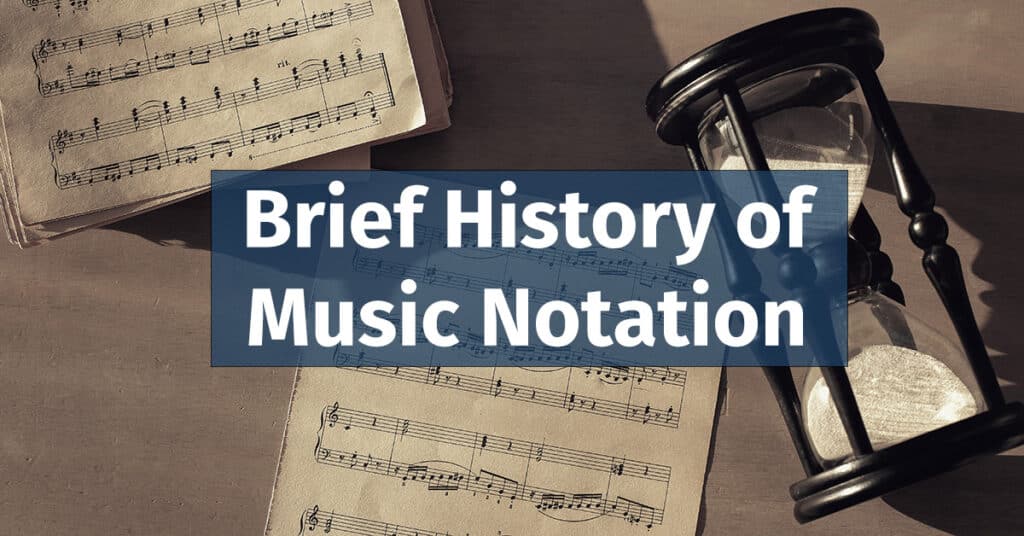Discover the history of music notation from its early beginnings to modern times. Learn how it transformed music preservation and reproduction.
Music has been a part of human culture since prehistoric times. Still, initially, there was no musical notation to represent sounds. This meant that each time a musical composition was to be performed, it had to be learned from scratch. This lack of musical notation limited the spread and preservation of many musical works throughout history.
- The Philosophy of Music
- Influence on Music Composition
- Guido d'Arezzo's Contribution
- The Advent of Modes and Their Evolution into Scales
- The Impact of Music Notation Development and Printing
- The Tonal System and the Basso Continuo
- The Evolution of the Music Staff
- The Importance of History of Music Notation
Music notation was first developed and used to record music in the 9th century, which allowed for its reproduction and permanent preservation. However, as we’ll see in the rest of the article, it took several centuries of experimentation and refinement for notation systems to become truly effective in representing all essential elements of music, such as pitch, duration, articulation, and loudness.
The Philosophy of Music
Music also has a philosophical and theoretical aspect related to the concept of harmony as a synthesis of contrasting elements. This theory has its roots in ancient Greece, with figures like Pythagoras, Plato, and Aristotle.
According to Pythagoras, harmony in music is achieved by mixing different contrasting elements, such as tension and relaxation, sound and silence, and high and low frequency. This mixture creates a balance that the listener perceives as pleasant and harmonious. According to this conception, music is something beautiful to listen to and a mathematical system of proportions and ratios that regulate sound production.
Plato considered music to be a superior art. He believed that it could transmit emotions and sensations through harmony and rhythm and that these could influence people’s moods and morals.
Aristotle challenged the Pythagorean theory of mathematical harmony, arguing that musical beauty cannot be reduced to a simple question of numerical ratios between sound frequencies. For Aristotle, musical beauty is a matter of proportions and balance between the parts of a composition, such as melody, harmony, rhythm, and lyrics (if present).

Influence on Music Composition
All three conceptions have influenced how music was composed and appreciated in subsequent centuries, but in different ways and times.
The Pythagorean theory of music as mathematical harmony and its emphasis on numerical ratios between sound frequencies strongly impacted the development of medieval and Renaissance music theory. This conception led to the development of the system of equal temperament, which allowed musical instruments to be tuned uniformly across their range.
The Platonic conception of music as a superior and transcendent art influenced how music was composed and appreciated in the Renaissance and Baroque periods. Composers sought to express complex emotions and ideas through music.
The Aristotelian theory of music as an art that imitates human emotions and actions has influenced how music was composed and appreciated in the Baroque and classical periods. Composers sought to create music representing human emotions and situations through rhetorical figures.
Guido d’Arezzo’s Contribution
During the Middle Ages, various methods of musical notation were used in Europe, including ones that detailed specific pitches and distances between notes and others that symbolically summarized melody progressions using neumes (ext. link).
Neumes consisted of various signs written above the lyrics of a chant, indicating the relative pitch and phrasing of the melody. They did not precisely dictate the rhythm, specific pitches, or the intervallic relationships between notes like modern notation does. Instead, they served as reminders of melodies already learned through oral tradition.
This early notation was rather ambiguous, often serving more as a mnemonic device for singers who already knew the melody rather than a comprehensive system that could be used to learn unfamiliar music.
However, this notation remained largely theoretical, with little practical use in the Western world until the 9th century when Gregorian chant popularized it. This contrasted with the Eastern Christian world, which had a rich tradition of musical notation.
The rise of Gregorian chant spurred the widespread use of musical notation, particularly synthetic neumatic notation, which tasked singers with preserving unnotated aspects of a chant (the pitch and duration of the sounds).
Over time, these neumes evolved to denote individual sounds rather than just melody flow and being placed on lines. Subsequently, the number of lines increased, with notes positioned on them, and the gaps between each line were effectively utilized.
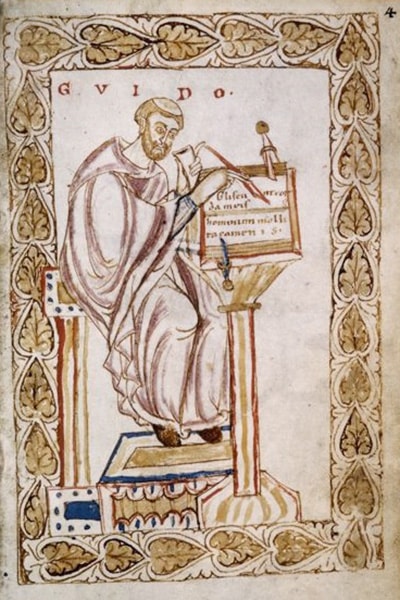
Guido d’Arezzo, a renowned Benedictine monk from Italy who lived circa 991 to 1033, is often acknowledged as the innovator behind the contemporary music stave we now use.
He introduced a system with four lines and their spaces, which enabled notes to represent sequential sounds, significantly advancing polyphony. Guido also introduced solmization, a forerunner to solfège, which greatly influenced Medieval Europe’s music understanding.
This system shifted the focus from theoretical speculations, rooted in Hellenistic literature and Pythagorean principles, to practical, experimental methods, forever changing how music was perceived.
Solmization
Guido d’Arezzo is often credited with developing the practice of solmization as we know it today. This system, designed primarily to ensure accurate intonation within a choir, introduced the use of syllables to denote pitches.
One of the challenges that singers faced was the interval known as the tritone, an interval spanning three whole steps, such as that between F and B. Notoriously dissonant and thus perceived as technically challenging, this interval naturally exists within the series of notes from C to B that forms the basis for Gregorian modes.
However, the melodies within these modes were composed so that the direct leap of a tritone was avoided, preventing the sound from becoming overly dissonant. Despite this, the tritone within the scale still contributed to the unique character of these modes.
The B note was often modified to a B flat to make this interval easier to navigate, transforming the problematic tritone into a more manageable perfect fourth. This adjustment led to the expansion of the musical system from seven to eight named notes, dispelling the common misconception that the system has always consisted of seven.
When considering all the distinct pitches within an octave on a keyboard, the count comes to twelve, not just the seven most commonly recognized.
Guido d’Arezzo introduced a practical solution to these complexities. He devised a sequence of six sounds, or a hexachord ranging from C to A, deliberately excluding the troublesome B flat and natural B. This hexachord was constructed of whole tones except for a semitone between E and F.
He further facilitated learning by introducing a significant system of solmization syllables. This system, derived from the hymn ‘Ut Queant Laxis’ dedicated to Saint John the Baptist, became a major contribution to music notation. This hymn, crafted by the Lombard historian Paul the Deacon, was the source for Guido’s unique method.
The hymn verses facilitate a straightforward learning approach through memorization. Utilizing the opening syllables of each verse – Ut, Re, Mi, Fa, Sol, La, and Si -Guido established a framework to interpret notated music using hexachords. It’s crucial to understand that these syllables were not definitive note names but flexible symbols that could represent any note, depending on their usage context.
This system created by Guido d’Arezzo is also responsible for the note nomenclature widely adopted in Romance languages: Ut (C), Re (D), Mi (E), Fa (F), Sol (G), La (A), Si (B and H). By the 17th century, “Ut” had been substituted with “Do” in many nations, except for France, where “Ut” remains in use.
The origin of the syllable “Do” is believed to either derive from Giovanni Battista Doni, an Italian music theorist, or the Latin term “Dominus,” which translates to “Lord.” This transformed nomenclature system continues to be foundational in understanding and interpreting musical notation.
Guido d’Arezzo gave us a standard way of measuring and applying musical sounds, marking a crucial step in the evolution of musical learning and performance.
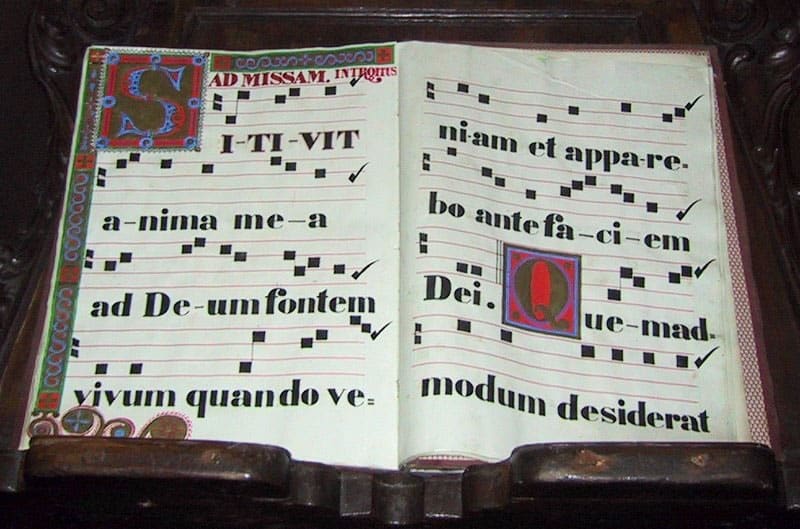
The key innovation here is Guido’s establishment of the hexachord as a fixed structure, which could be applied universally across the musical octave. This approach is comparable to our modern major and minor scales, diverging from the modes based on specific sounds and interval sequences.
Guido d’Arezzo’s innovative system laid the groundwork for a significant shift in music theory. His introduction of the hexachord, a versatile structure, could be navigated throughout the octave and beyond. The need for its mobility stemmed from aligning semitones in the hexachord with those in the octave.
This system established three configurations, natural, soft, and hard positions, depending on the positioning of notes within the hexachord. The selection of hexachords depended on the composition of the melody.
If the melody did not include a B note, the natural hexachord was utilized for solmization. In contrast, if a B note was present, either the soft or hard hexachord would be used, depending on whether the B note was lowered or not.
This decision was further influenced by the occurrence of a “Diabolus in musica”. The method of smoothly transitioning from any point within one hexachord to any other point within a different hexachord constituted the practice of solmization.
Shifting accurately between hexachords during solmization was challenging, given the variable names of sounds based on the hexachord’s position. A learning aid, the Guidonian hand, was developed to help apprentice singers navigate this complexity.
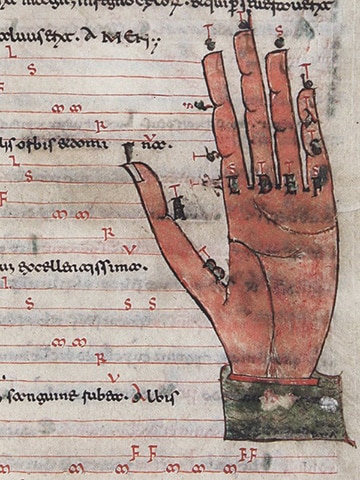
Beyond the natural sound sequence, the E-F interval was adjusted across all twelve semitones within the octave, leading to nine additional hexachord positions and thus complicating the system. This development was termed “musica ficta” (fictitious music).
The Guidonian system transformed the music world. Previously, melodies were limited to a single sound mode. With Guido’s hexachord, melodies could modulate between modes, thus breaking free from their traditionally fixed characteristics.
This enabled infinite possibilities for blending modes, marking the advent of modern musical tonality.
The Advent of Modes and Their Evolution into Scales
The story of musical modes is an exciting journey that begins in ancient Greece. In those times, modes were known as harmoniai or tonoi. Dorian, Phrygian, Lydian, and Mixolydian were the names they went by. Still, these are distinct from the medieval modes that share these names.
In the Middle Ages, around the 9th century, the Church breathed new life into modes. They used them to categorize Gregorian chant, which resulted in an octet of church modes: four original or authentic modes (Dorian, Phrygian, Lydian, and Mixolydian) and their corresponding plagal versions (Hypodorian, Hypophrygian, Hypolydian, and Hypomixolydian).
These modes were the lifeblood of Western music’s melodies until the late 16th century. The Renaissance was a time of change for the modal system. Aeolian and Ionian modes, or as we better know them today, minor and major scales, began to win the hearts of composers like Palestrina. By the late 16th century, they were on the rise.
The Baroque era was a turning point when our familiar major and minor keys system took center stage, nudging aside the modal system. The tonal system was the new star, offering a richer canvas of expressive possibilities, especially regarding modulation or key changes within a composition.
Our modern understanding of modes refers to the ancient Greek system, now called the diatonic modes. These modern seven modes (Ionian, Dorian, Phrygian, Lydian, Mixolydian, Aeolian, and Locrian) are variations of the major scale.
The Impact of Music Notation Development and Printing
Polyphony requires precise notation for pitch, duration, and rhythm. While pitch had been indicated previously by the position of notes on a system of lines, duration still needed to be represented. The mensural notation (ext. link) allowed for both pitch and duration to be indicated.
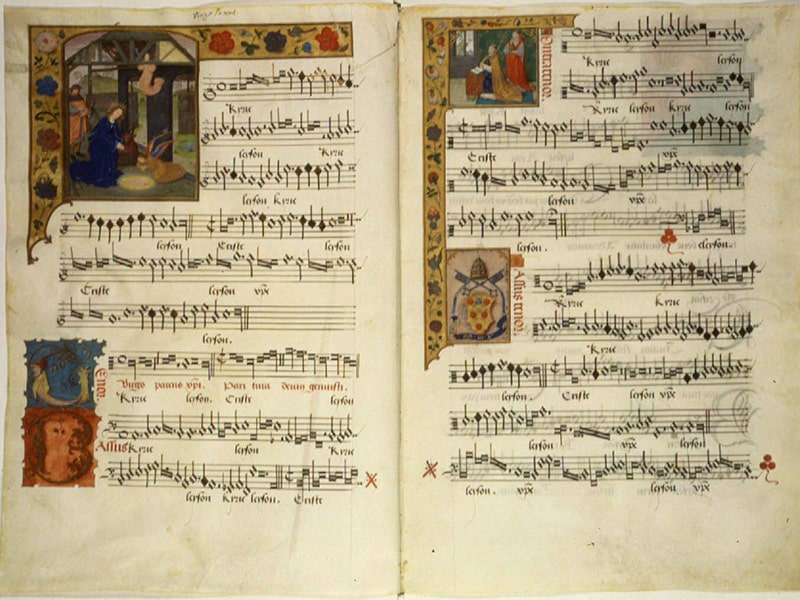
The introduction of music printing allowed for the widespread and rapid distribution of sheet music. This contributed to standardizing notation and made it more accessible to a broader audience.
The Tonal System and the Basso Continuo
In the XVII century, music developed using the tonal system, which is a musical system based on tonality, the relationship between the reference note (tonic) and the other notes of the scale.
The foundations of the tonal system, whole steps (or tones) and half steps (or semitones), are concepts with roots tracing back to ancient civilizations. In order to understand the tonal system, it’s crucial to comprehend these fundamental units.
A whole step, or tone, is the interval that covers the distance of two half steps. It is equivalent to moving from one note to a second note that is two positions away on the diatonic scale, such as moving from C to D or D to E in the C major scale.
On the other hand, a half step, or semitone, represents the smallest interval used in the Western tonal system. This is equivalent to a move from one note to the very next in a diatonic scale, such as from C to C# or from E to F in the C major scale.
Originally, music was based on simple ratios. Ancient Greeks, particularly Pythagoras, discovered that the most harmonious musical intervals are those with the simplest frequency ratios. This formed the basis of the Pythagorean tuning system, where all intervals are composed of whole steps, except for the interval between the seventh and eighth notes, which is a half step. However, this system had limitations, as it didn’t allow for modulation, or changing of key.
The concept of semitones emerged more fully during the Middle Ages, alongside the development of the hexachord system. This system, used from the 9th to the 16th century, was based on six-note patterns that included a semitone between the third and fourth notes.
The evolution of tones and semitones played a crucial role in the development of the tonal system in the Baroque period (1600-1750). The advent of the well-tempered tuning system, which adjusted the Pythagorean system to allow for modulation, was particularly important. This system used a series of twelve equally spaced semitones, enabling composers to write music in any key.
The “basso continuo” technique, popular in the Baroque period, is an excellent example of the application of this system. With the chords indicated by figures above or below the bass line, the performer could fill in the harmony, guided by the understanding of the relationships between the notes, which were formed by the interplay of tones and semitones.
Thus, the development of tones and semitones has been instrumental in shaping the way we understand and create music today.

The Evolution of the Music Staff
After the era of Guido d’Arezzo, a shift began towards a more versatile system. The initial four-line staff served the needs of pastoral music wonderfully. Still, as the Renaissance began around the 14th century, music began to reach new heights of complexity, and the limitations of the four-line staff started to show. The solution was adding another line.
The extra line, debuting around the 16th century, offered additional range and adaptability, allowing composers to express their creativity better. This five-line staff, which might seem so ordinary to us now, was a true game-changer back in the day.
However, the five-line staff continued beyond its extra line. Its evolution continued with adopting various musical symbols, offering guidance on everything from pitch and rhythm to the finer nuances of dynamics and tempo.
The clefs – our landmarks on the staff – also morphed over time. We ended up with the familiar trio of the G clef (our treble clef), the F clef (the bass clef), and the adaptable C clef, used in different positions for different vocal ranges.
Key signatures and time signatures, providing insight into a piece’s tonality and rhythmic framework, also found their home on the staff. Bar lines also debuted, chopping up the staff into bite-sized measures and making music notation easier and more organized.
The Importance of History of Music Notation
The history of music notation is a rich and fascinating topic that reveals how humans have sought to capture and communicate the beauty and complexity of the music.
These developments made music notation more precise and efficient, allowing musicians to write and read music more quickly and accurately. Today, musical notation is a fundamental element of Western music, used by composers and musicians worldwide to communicate ideas and create new musical works.
The staff has undergone numerous developments and modifications throughout the history of music notation, leading to the creation of the modern staff. This process was gradual and required the contributions of many creative minds over the centuries. It is possible that in the future, with technological and artistic progress, there will be further developments in how we use the staff in music.
